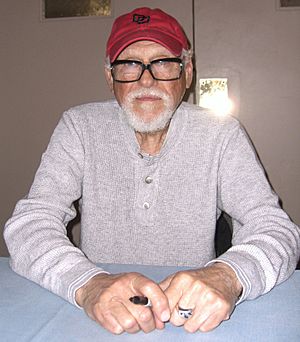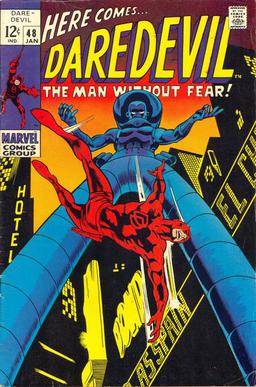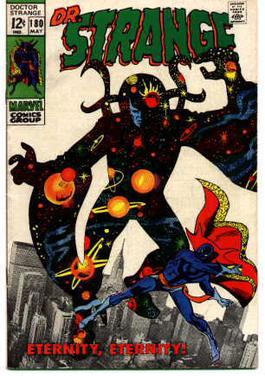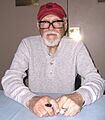Gene Colan facts for kids
Quick facts for kids Gene Colan |
|
|---|---|

Colan at the Big Apple Summer Sizzler in Manhattan, June 13, 2009
|
|
| Born | Eugene Jules Colan September 1, 1926 The Bronx, New York |
| Died | June 23, 2011 (aged 84) The Bronx, New York |
| Nationality | American |
| Area(s) | Penciller, Inker |
| Pseudonym(s) | Adam Austin |
|
Notable works
|
Daredevil Detective Comics Batman Doctor Strange Howard the Duck The Tomb of Dracula |
| Awards | Eagle Award, 1977, 1979 Eisner Award, 2010 |
| Spouse(s) | Sallee Greenberg (divorced) Adrienne Colan (Brickman) |
Eugene Jules Colan (born September 1, 1926 – died June 23, 2011) was a famous American comic book artist. He was best known for his amazing work with Marvel Comics. He drew popular characters like Daredevil, Howard the Duck, and The Tomb of Dracula.
Gene Colan also helped create some important superheroes. He co-created the Falcon, who was the first African-American superhero in mainstream comics. He also helped create Carol Danvers (who became Ms. Marvel and Captain Marvel) and the vampire hunter Blade. In 2005, he was added to the Will Eisner Comic Book Hall of Fame. This is a very special honor in the comic book world.
Contents
Early Life and Art Beginnings
Eugene Jules Colan was born on September 1, 1926, in The Bronx, New York City. His father, Harold Colan, sold insurance, and his mother, Winifred Levy Colan, was an antique dealer. Gene started drawing when he was only three years old! He said his grandfather was his favorite person to draw.
When he was young, he was inspired by the adventure comic strip Dickie Dare. He also tried to copy the art of Norman Rockwell, who drew covers for The Saturday Evening Post. Other artists who influenced him were Syd Shores and Milton Caniff. Gene Colan went to George Washington High School and later studied art at the Art Students League of New York.
Starting a Career in Comics
Gene Colan began working in comics in 1944. His first published work was a one-page drawing for Wings Comics. This was a summer job before he joined the military. He later drew a seven-page story for the same comic.
During World War II, Colan joined the Army Air Corps. He was stationed in the Philippines, where he drew for the Manila Times newspaper. After the war, in 1946, he started working for Marvel Comics' early company, Timely Comics. He was hired as a "staff penciler."
He also worked for DC Comics, drawing war stories for titles like All-American Men at War. He was very careful to research his war stories to make them accurate. In the 1950s, he drew for the Hopalong Cassidy comic series, which was based on a popular Western hero.
The Silver Age of Superheroes
In the 1960s, Gene Colan started drawing superheroes for Marvel Comics. He sometimes used the name Adam Austin. He drew the "Sub-Mariner" feature in Tales to Astonish and "Iron Man" in Tales of Suspense.
Soon, Marvel editor Stan Lee convinced Colan to work for Marvel full-time. Colan became one of the most important artists of the Silver Age at Marvel. He drew many famous characters, including Captain America and Doctor Strange. His most famous work was on the Daredevil series. He drew almost every issue of Daredevil from 1966 to 1973.
To make his Doctor Strange drawings realistic, Colan would visit Greenwich Village in Manhattan. He would take Polaroid photos of the neighborhood to use as references for his art.
In 1969, Colan and writer-editor Stan Lee created the Falcon. This was a very important moment because Falcon was the first African-American superhero in mainstream comic books. Colan also helped create the original Guardians of the Galaxy in 1969.
Dracula, Howard the Duck, and Batman
In the 1970s, Gene Colan drew the entire 70-issue run of the popular horror comic The Tomb of Dracula. He also drew most issues of the funny and unique series Howard the Duck.
For The Tomb of Dracula, Colan and writer Marv Wolfman created new characters like Blade (in 1973) and Lilith (in 1974). Blade later became a very popular character, even starring in movies. Colan's work on The Tomb of Dracula is considered one of the best horror comics of the 1970s.
His work on Howard the Duck was also very famous. The character was even nominated for president in a fictional political campaign in 1976! Writer Steve Gerber, who worked with Colan on Howard the Duck, said they had a "telepathic connection" because Colan drew exactly what Gerber imagined.
In 1981, Colan moved back to DC Comics. He brought his unique, shadowy art style to Batman. He was the main artist for Detective Comics and Batman from 1981 to 1986. With writer Gerry Conway, he helped bring back old villains like Doctor Death and the Monk. He also helped create the new villain Killer Croc in 1983. Killer Croc later appeared in the 2016 movie Suicide Squad.
Colan also worked on Wonder Woman and helped create a new "WW" emblem for her costume. He also drew the Phantom Zone series and Night Force.
Gene Colan's art style was very special. He used flowing lines and a lot of shadows, which made his drawings look very moody and dramatic. He often worked as a penciller, and Frank Giacoia and Tom Palmer were his most frequent inkers.
Later Career and Life
Later in his career, Colan continued to draw for various comic companies. He worked on Jughead's Time Police for Archie Comics. He also returned to Marvel to work on a new The Tomb of Dracula series and a Black Panther story.
In 1998, Colan and Marv Wolfman worked together again on The Curse of Dracula for Dark Horse Comics. He also drew for a Buffy the Vampire Slayer comic in 2001. In 2007, he drew some flashback scenes for the Blade comic series, showing Blade in his original costume. He also drew pages for Daredevil vol. 2, #100.
Besides drawing comics, Colan taught art at the School of Visual Arts and the Fashion Institute of Technology in Manhattan. He also had art shows in galleries. He lived in Vermont for a while before moving back to Brooklyn, New York.
In 2008, Colan had some health problems, but he recovered enough to continue drawing. In 2009, he drew Captain America #601, which won him an Eisner Award.
Personal Life
Gene Colan was married twice. He had two daughters, Valerie and Jill, with his first wife, Sallee Greenberg. With his second wife, Adrienne Brickman, he had a son named Erik and a daughter named Nanci. Adrienne Colan passed away in 2010.
Gene Colan died in The Bronx on June 23, 2011, at the age of 84. He passed away due to complications from cancer and liver disease.
Awards and Recognition
Gene Colan received many awards for his amazing work in comics:
- His work on Howard the Duck won the Eagle Award for Favorite Comic Book (Humor) in 1977 and 1978.
- He received an Inkpot Award in 1978.
- In 2005, he was inducted into the Will Eisner Comic Book Hall of Fame.
- He won the 2010 Eisner Award for Best Single Issue for his work on Captain America #601.
- The Cartoon Art Museum in San Francisco held an art show called "Colan: Visions of a Man without Fear" from 2008 to 2009.
- He received the 2008 Sparky Award and the Comic Art Professional Society's Sergio Award in 2009.
Images for kids
-
Colan at the Big Apple Summer Sizzler in Manhattan, June 13, 2009
See also
 In Spanish: Gene Colan para niños
In Spanish: Gene Colan para niños








